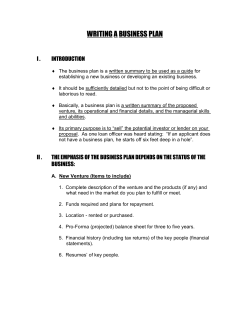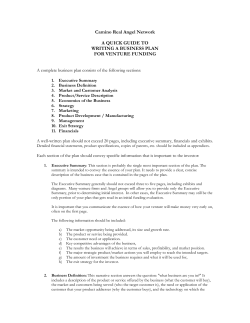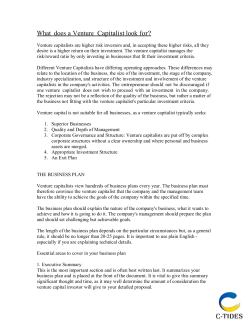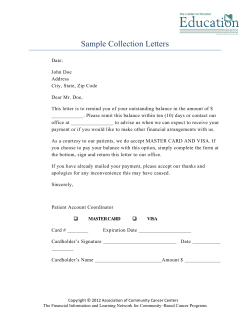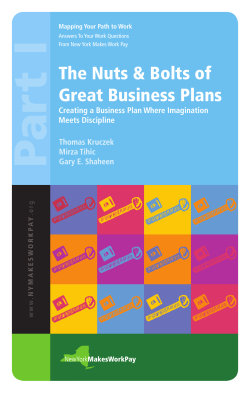
Business Overview
MODULE 2 Business Overview Introduction……………………………………………………………………. Projected Outcomes ………………………………………………………….. Facilitator’s Notes………………………………………..…………………… The 5 W’s: Answering the Questions………………………………………… Who…………………………………………………………………….. What……………………………………………………………………. Why…………………………………………………………………….. Where………………………………………………………………….. When…………………………………………………………………… Vision and Mission Statements………………………………………………. Preparing a Mission Statement………………………………………………. Types of Business Ownership…………………………………………………. Business Communication Skills………………………………………………. 22 23 23 24 24 24 25 25 26 27 28 29 29 Participant Activities Creating A Mission Statement………………………………………………. Facilitator’s Notes…………………………………………………………….. 30 31 21 MODULE 2 Business Overview Introduction: The business overview is just that, an overview of relevant “tombstone” data of the venture. This section of the business plan answers the what, why, who, where, and when questions for the business in a concise manner. In addition, this section of the business plan usually contains the company mission statement, goals, and objectives. Although this section seems redundant to some entrepreneurs because the 5 W’s are answered throughout most business plans, it provides the reader with a quick glimpse of the business. This module will provide the participants with basic business “knowledge” while developing business communication abilities. Each of the 5 W’s will be discussed in terms of expectations and requirements. Mission statement development is not an easy task. A mission statement basically envisions what your business can and wants to be in the future. Mission statements allow an organization to have an ultimate goal to reach for and a “sounding board” for decision-making. Critical decisions concerning your business direction can easily be construed as consistent with your mission statement or not! 22 MODULE 2 Business Overview Business Overview Projected Outcomes: Upon completion of Module 2, participants will be able to: • • • • • • • • • Describe basic forms of business ownership Differentiate between long a nd short term business goals Understand the role of business location as part of marketing Understand the principles of effective business and journalism communications Understand the principles and benefit of vision and mission statements Develop vision and mission statements as part of a team Develop teamwork skills Develop creative and critical thinking skills Develop research skills Facilitators Notes: What is the importance of the 5W’s to a business plan? What skills are necessary in order to complete this module? Remember a business plan is written for a number of purposes. This section is of interest to potential funders, lenders, and/or investors. The business overview provides the reader with enough information to ascertain whether they want to read about the business further. The business overview should be concise, relevant, interesting, and utilize positive business terminology. 23 MODULE 2 Business Overview The 5 W’s: Answering the Questions 1. Who: Who are the principle owners of the business? List all owners and include their titles or role in the business. For example: “Cheeter’s Management Services is owned and operated by John Doe, General Manager, Jane Doe Marketing Coordinator, and Alley Yoop, Operation Manager. This venture is an equal, unlimited partnership between principles.” 2. What: What type of product or service is the business offering? Remember keep the language positive and upbeat. For example: “Cheeter’s Management Services provides a full service event consulting and management sevices consistent with the Aboriginal culture and traditions. This service is unique to the Project Management industry within Canada and provides Cheeter’s Management Services with a competitive advantage over our competitors.” 24 MODULE 2 Business Overview 3. Why: Why does this business make sense? Why will it be commercially viable? Why are the proponents of this plan starting this business? This is the section where participants can showcase or highlight key features of their business venture. Remember keep the response “short and sweet”, just the facts. For example: “Event planning and management is a $25 million dollar industry within Canada and has experienced substantial growth in both market share and profitability. Event planning and management has been experiencing a 10% growth in industry size over the course of the past 5 years. Cheeter’s Management Services intends to capture 5% of this market through superior customer service and tailoring our services to meet the needs of our target market. Proponen ts of Cheeter’s Management Services recognized the need for this service in the Aboriginal market/community through surveys, secondary research, and direct market knowledge. Cheeter’s Management Services is entirely Aboriginal owned and operated ….” I think you get the idea! Promote your business by incorporating positive language, highlighting/showcasing your competitive advantages, and demonstrating business viability. 4. Where: This is the easiest section, where is your business located? Location refers to the legal address of the business, where does the mail go? Even if your partnership is operating from home(s), one address must be used for mailing purposes etc. In addition, if your business is located in a commercial location what are the key factors for choosing this location? For example: “Cheeter’s Management Services is located at ________________________, Winnipeg, Manitoba. This location is an ideal location to base our activities because …” 25 MODULE 2 Business Overview 5. When: This section provides the reader with some background on the business. When was the partnership formed, when was the business formed, and when will the business be launched are some of the questions this section of the business overview answers. In addition, this section may answer some questions your team felt were self -evident, such as why start the business in the spring or fall? The following example may illustrate this more clearly. “Cheeter’s Management Services was formed in July 2001 by John Doe, Jane Doe, and Alley Yoop through a general partnership agreement. Although formed in 2001 Cheeter’s Management Services will not begin operations until March 2002. The start date for beginning operations coincides with event season. Cheeter’s Management Services will take advanta ge of the seasonal nature of the event management industry to maximize our return on investment and reduce unnecessary overhead expenditures.” In this example the business owners felt they required 6 to 9 months development time in order to launch their business venture. In addition, the majority of events planned in Canada are in the spring, summer and early fall to take advantage of the milder weather. Cheeter’s Management Services did not feel the paying office space was necessary at this time, instead the money saved can be utilized for marketing, office equipment, etc. 26 MODULE 2 Business Overview Vision and Mission Statements: What is the purpose of a vision statement? Is it necessary to have a company vision statement? How to you develop a vision statement? What is the purpose of a Mission Statement? Is it necessary to have a mission statement? What is the process for developing a mission statement? Vision statements and mission statements are often referred to as the “what and how statements” of the business plan. These statements provide general overall guidance to the business over the long term. Vision statements describe the nature of your business as well as the business’ ultimate goals in a single sentence. If this sounds difficult to do it is because it is! Mission statements set a direction for a business. Mission statements reflect the objectives required to meet your business goals. If a business plan is the “map” a business follows for success, then the mission statement is the compass that sets the direction for that journey. Making money is never part of the mission statement! Mission statements will provide the reader of the business plan and employees of the business to understand who the business is, what values your company believes in, and set the tone of the business to inspire and motivate customers and staff. Not all companies have a mission statement but it is recommended. Preparing a Mission Statement: When preparing this mission statement keep in mind that the busine ss idea may evolve over the course of the competition and changes will have to be incorporated in the mission statement. In addition, although mission statements are generally very short, they are extremely difficult to write, so take your time! 27 MODULE 2 Business Overview The team should begin by “brainstorming” ideas about what they want to accomplish with this business, what values or principles will they incorporate into the mission statement. Remember a mission statement should “make your customer want to do business with your company”. Mission statements are specific objectives that you need to meet to further the business towards your ultimate goal, success. Example: Mission Statement Star Trek’s “mission” was to “seek out new life, to go boldly where no one has gone before.” This Mission Statement is short and sweet as well as incredibly powerful. Try and keep the mission statement to 1 or 2 sentences in length. Example: Vision Statement and Mission Statement Cheeter’s Management Services Vision Statement: Cheeter’s Management Services will be recognized as a leading champion in event planning and organization. Mission Statement: Cheeter’s Management Services will consistently provide outstanding customer service and beat the competition with dedication and professionalism. In the next 36 months, we will achieve a 10% growth. 28 MODULE 2 Business Overview Types of Business Ownership: For most of the participating teams the business will be structured as a “Partnership” between team members. Although for general information and understanding we have included this section concerning the “Forms of Business Ownership”. There are basically 3 forms of business ownership: § § § Sole Proprietorship Partnership, General and Limited Incorporated, Corporations (Overhead Provided) Business Communication Skills: An overhead has been provided outlining some “tips” for preparing business documents. It should be emphasized that communications skills is the number 1 skill employers are seeking from potential employees. 29 Participant Activities Creating a Mission Statement Mission statements set the objectives for a business venture. Mission statements outline “how” you are going to accomplish your goals. “In relation to the vision statement, which presents an image of what we aspire to become, the mission statement tells how we are going to do business in order to fulfill the vision. The vision is the place we want to go to or the journey we want to take; the mission is the means for traveling.” Karl Albrecht Activity 1: Creating a Vision and Mission Statement Materials: Flip chart, black/white board, and BDC supplied overheads Time: Dependent upon goals, approximately 3-4 hours Activity A: As a group/team brainstorm answers to the following questions: Vision Statements: 1.Where do you want your business to be in 2, 5, or 10 years? 2.What will you have accomplished? 3.What common values does the business operate under? Example: Example answers are generic in nature. To be recognized as a leader in the field of customer service. Increased business by 100% in 5 years. Expanded to nationwide franchise. Original store increased in size. Diversified product line increases market share. We will operate the business with integrity, honesty, a customer focus, to contribute back to the community, etc. 30 Participant Activities Activity B: As a group/team brainstorm answers to the following questions: 1. 2. 3. 4. 5. What is our business and why are we in it? What makes our business unique? Who is our customer? How do we want to treat our customers? What is our primary product or service? Example: Example answers are for a coffee shop but are generic in nature. We sell coffee. We provide a place to sit and relax. It will become a social gathering spot. Shop will be perceived as a “trendy” place to go! Shop will have a distinct Aboriginal atmosphere. We will focus our business towards people 18 – 35 years of age. Customer service and variety will keep the customer coming back! We will guarantee our product to the customer’s satisfaction. Coffee from around the world will be the product. Our competitive advantage is our knowledge of the customer and market. Facilitators Note: This is a difficult process for an experienced businessperson so be prepared to guide the participants through the exercise, contribute ideas, and help them focus on setting long-term goals or the “vision statement” for their venture. 31
© Copyright 2025









